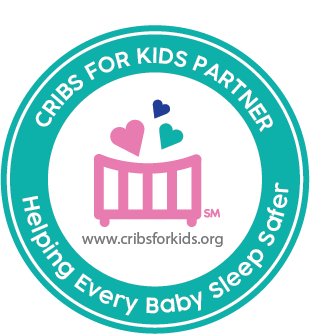updated Sept 29, 2025 – Choking is a common cause of injury and death in children. While this sounds scary, the good news is that choking is usually preventable. By learning choking first aid for infants and how to reduce risks, parents and caregivers can respond quickly and confidently if it ever happens. You can also learn more first aid skills before baby arrives here.
Choking First Aid for Infants: How to Recognize Choking
Recognizing choking is critical: if your baby is coughing or gagging, this is the body’s natural reflex to clear a partial blockage, and you should encourage them to keep coughing as long as they are making noise and breathing.
However, if your baby is unable to breathe, cry, or make any sound or if their skin begins turning blue, it may indicate a total airway obstruction. This is a medical emergency requiring immediate action. Be prepared to help baby by reviewing the steps below to understand choking first aid and call 911.
What To Do If a Baby Is Choking
If your baby is choking and unable to breathe or make a sound:
- Call 911 immediately (or have someone else call).
- Give up to 5 back blows:
- Hold the baby face down on your forearm, supporting the head and neck.
- Deliver 5 firm back blows between the shoulder blades with the heel of your hand.
- Give up to 5 chest thrusts:
- Turn the baby face up, still supporting the head.
- Place two fingers in the center of the chest, just below the nipple line.
- Push down about 1.5 inches, quickly and firmly, up to 5 times.
- Alternate between 5 back blows and 5 chest thrusts until the object is expelled.
- If the baby becomes unresponsive, begin CPR and continue until help arrives.

Preventing Choking in Infants
Parents and caregivers can help reduce choking risk by making safe choices every day:
- Bottle feeding safely
- Always hold your baby during feeds—never prop a bottle with pillows or devices.
- Make sure the nipple flow is correct for your baby’s age; too fast a flow can overwhelm them.
- Choosing developmentally appropriate foods
- Wait until your baby shows signs of readiness (usually around 6 months) before introducing solids.
- Offer smooth, soft foods when starting solids. Avoid round, hard, or sticky foods such as hot dogs, grapes, popcorn, raw vegetables, nuts, and chunks of cheese until at least age 4.
- Cut food into very small pieces—no larger than half an inch—once finger foods are appropriate.
- Creating a safe environment
- Keep coins, buttons, small toys, batteries, and other objects that could fit through a toilet paper roll out of reach.
- Get down on the floor at baby’s level to spot choking hazards you might otherwise miss.
Key Takeaway
Choking is a leading cause of injury in infants, but it doesn’t have to be. Parents and caregivers can prevent most choking incidents by supervising feeds, offering age-appropriate foods, keeping small objects out of reach, and knowing what to do in an emergency. Learning Infant CPR and First Aid before your baby arrives is one of the best ways to keep your child safe.
Read our Essential Guide: How To Prepare Your Home for a Newborn for more safety guidelines and tips.





